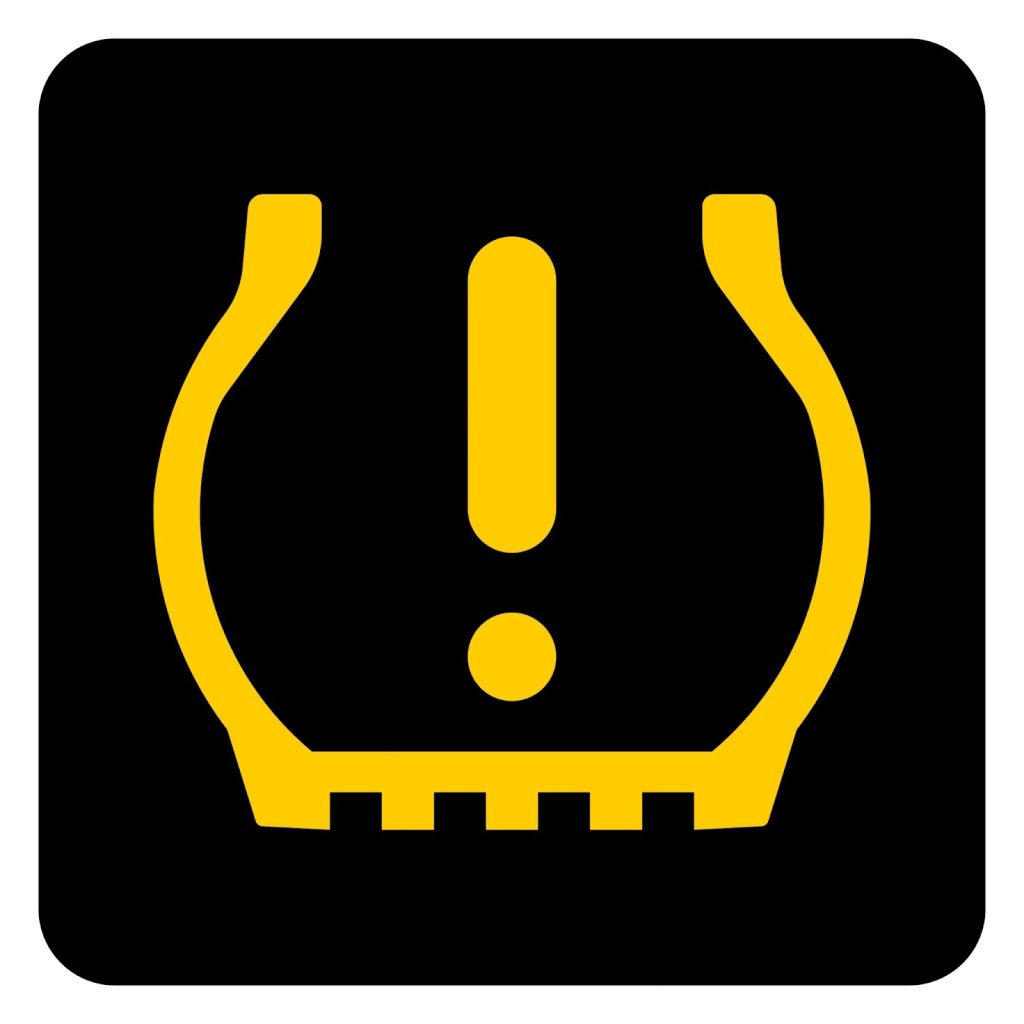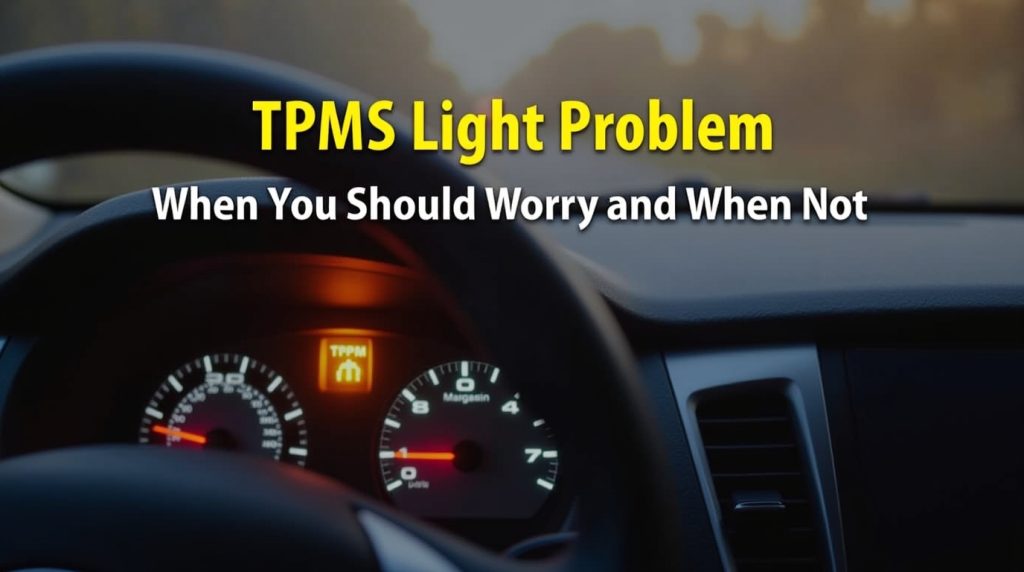In today’s vehicles, technology plays a critical role in safety and performance. One such feature is the Tire Pressure Monitoring System (TPMS), which constantly checks the air pressure in each tyre. That little horseshoe-shaped TPMS light with an exclamation point can be confusing; when it flashes on your dashboard, it often feels like a serious warning.
However, while the TPMS’s job is to warn you about pressure issues, not every appearance signals an emergency. Sometimes, it is simply due to a weather change or a minor electronic glitch. The challenge is knowing if you face a true safety warning or a false alarm. In this guide, we will clear up all the confusion and explain the most common reasons your TPMS light activates. By the time you finish reading, you’ll understand exactly when you can relax and when it’s time to check your tyres. Keep reading to decode your dashboard and drive with confidence.
Key Takeaways
- The TPMS light indicates tyre pressure issues or system malfunctions, with solid and blinking lights signaling different problems.
- A solid TPMS light usually means low pressure, requiring immediate action to ensure safety, while a blinking light indicates a system error.
- Temperature changes and battery failures commonly trigger the TPMS light, often confusing drivers about the cause.
- Follow a structured plan: check air pressure, reset the TPMS system, and address sensor failures to effectively manage TPMS light alerts.
- Regularly check tyre pressure to prevent issues; understand when the TPMS light signals real emergencies vs. minor concerns.
Table of Contents
- What Does the TPMS Light Actually Do?
- Solid vs Blinking TPMS Light Warning
- Why Does the TPMS Sensor Light Turn On?
- Addressing Model-Specific TPMS Issues and the Calibration Gap
- Why Calibration Matters, Especially for Honda?
- When the TPMS Warning Signals Danger
- TPMS Light Blinking: When You Don’t Need to Panic
- A Simple Action Plan When the TPMS Light Activates
- Tire Pressure Monitoring System’ Light Diagnostic Summary
- Conclusion
- FAQs
What Does the TPMS Light Actually Do?
Many drivers see the yellow symbol and immediately ask, What is the TPMS light? Simply put, the Tire Pressure Monitoring System (TPMS) is a dedicated safety system. It acts as a continuous digital observer, monitoring the air levels inside your tyres. Its goal is simple: ensure your tyres maintain the exact pressure needed for safe driving.
What Does the Dashboard Symbol Represent?
The illuminated icon, known as the TPMS indicator light, is shaped like a flattened tyre with an exclamation point in the centre. When the TPMS dashboard light turns on, it signals that the system has detected a significant discrepancy in tyre pressure or an error within the system itself.
This light is essential because tyres often look normal even when severely underinflated. The system alerts you before a low-pressure condition leads to a dangerous failure.
Different TPMS Light Systems Explained
Not all systems work the same way, which impacts how you troubleshoot.
Some cars use Direct TPMS. This system places a battery-powered pressure sensor inside the valve stem of each tyre. These sensors provide real-time pressure data. They are highly accurate, but their batteries eventually die, which is a known maintenance point.
Other cars use Indirect TPMS. Instead of internal sensors, this system monitors the rotational speed of each wheel using the Anti-lock Braking System (ABS) sensors. If one tyre loses air, its diameter shrinks. This causes it to spin faster than the others. The system flags this difference as low pressure. This type is less expensive and often used in models like Honda.

Solid vs Blinking TPMS Light Warning
The key to diagnosing the problem lies in how the light behaves. The difference between solid and flashing is the difference between a tyre emergency and a system malfunction.
The Solid Light Means Low Pressure
If the Tire Pressure Monitoring System’s light on the dashboard stays illuminated and steady (solid yellow), it’s a low-pressure warning. This is the most common reason you see the TPMS light on the dashboard.
The system is designed to trigger when pressure drops 25% below the manufacturer’s recommended level. A steady glow is the true TPMS light meaning: you must address the pressure immediately. This is the clear signal from your TPMS warning light that your safety margin is compromised.
The Blinking Light Signals System Malfunction
If you see the TPMS light flashing for about 60 to 90 seconds before it stays solid, that’s a different story. The blinking light indicates a system malfunction.
This means the car’s computer knows the system itself is broken. It could be a dead sensor battery, a faulty module, or a communication issue. When the light blinks, the system cannot monitor your pressure, which is what the TPMS light means in this context: the guard dog is asleep. This is sometimes called a flashing TPMS light error.
Why Does the TPMS Sensor Light Turn On?
There are a few key reasons why you might suddenly see the TPMS sensor light on your dashboard.
Temperature Changes Affect Tire Pressure
The TPMS sensor light frequently appears in the morning, especially during cold snaps. This happens because air contracts in cold weather, reducing tyre pressure. For every 10-degree Fahrenheit drop, your tyres can lose about 1 PSI.
If your tyres were already near the low end, a cold night can push them below the safety threshold, causing the TPMS lights to turn on. As you drive and the tyres warm up, the light might disappear, but you still need to add air when the tyres are cold.
Sensor Battery Failure
Direct TPMS sensors rely on internal, non-replaceable batteries. These batteries typically last between five and ten years, depending on driving habits and conditions.
When the battery weakens, the sensor sends erratic or no signals, triggering the blinking light sequence. A failed sensor is a very common reason for the TPMS sensor light to fail.
Hidden Leaks Cause TPMS Activation
Sometimes, the TPMS light on the car signals a very slow leak that is invisible to the naked eye. This can be caused by a small puncture, a faulty valve stem, or a poor seal where the tyre meets the rim. A consistent, solid TPMS car light should prompt an inspection for these subtle leaks.

Addressing Model-Specific TPMS Issues and the Calibration Gap
Many drivers get frustrated because they check the pressure, fill the tyres perfectly, and the light still won’t go off. This often points to a problem with calibration, particularly in vehicles that use the Indirect TPMS system.
Why Calibration Matters, Especially for Honda?
If your tyres are inflated correctly, but the light refuses to turn off, you likely have a calibration issue. This is extremely common with cars using the Indirect TPMS, which includes many popular models.
The Nuance of Honda’s TPMS System
If you drive a Honda, you are likely using the Indirect TPMS (i-TPMS). This is why searches for TPMS light Honda are so popular. Since the system measures wheel speed, simply adding air isn’t enough. The car’s computer needs to be told that the newly inflated tyre speed is the “new normal.”
If you top off the tyres in your TPMS light Honda Accord or TPMS light Honda Civic, the light might stubbornly stay lit. This is the issue behind people claiming the Honda TPMS light is on, but the tyres are fine. The tyres are fine now, but the car’s memory is not.
Required Calibration Steps
If you see the TPMS light Honda Accord or the TPMS light Honda Civic illuminated, calibration is often the fix. This process is how you perform a lasting reset after inflation.
For many newer models, the process involves navigating the dashboard menu:
- Select “Settings” from the Home screen.
- Choose “Vehicle” or “Customise Settings”.
- Select “TPMS Calibration” and then “Calibrate” or “Initialise”.
Vehicles like the Honda Odyssey TPMS light or Honda Pilot TPMS light may also have a physical reset button near the steering column. Hold it until the Tire Pressure Monitoring System’s light in the Honda blinks twice. The calibration completes after driving for about 20–30 minutes at highway speeds. This simple reset is also vital for the TPMS light on the Honda CR-V and the Honda Fit TPMS light. Ignoring this step is the main reason the light persists.
When the TPMS Warning Signals Danger
While calibration issues are common, the Tire Pressure Monitoring System’s light is a safety device for a reason. You must understand when to treat the warning as an emergency.
Critical Risks of Low Tire Pressure
A solid TPMS dash light means your tyre is severely under-inflated, which presents several risks:
- Blowouts: Under-inflation causes the tyre sidewalls to flex excessively, generating heat that can lead to sudden, catastrophic failure, especially at high speeds.
- Poor Handling: Low pressure compromises traction and stability, making it difficult to grip the road, steer accurately, and stop quickly.
- Suspension Damage: The extra flexing puts undue stress on shocks and suspension components, leading to expensive long-term repairs.
Anything below 20 PSI is functionally a flat tyre and requires immediate action. If your Honda warning light TPMS is solid, pull over safely and check the pressure now.
The Cost of Ignoring the TPMS Light
Besides safety risks, ignoring it drains your wallet. Low pressure increases rolling resistance, reducing your fuel economy by up to three per cent. It also causes uneven wear on the tyre shoulders, shortening the lifespan of your tyres and forcing premature replacement.

TPMS Light Blinking: When You Don’t Need to Panic
The light is sometimes oversensitive. Certain situations trigger a warning that isn’t a long-term emergency.
Cold Weather Is a Common Culprit
If you see the light activate on the coldest day of the year, it’s usually just physics. Once the tyres warm up from driving, the pressure may rise and the light may go off. However, even if the light goes out, you should still add air, as the pressure was genuinely low when cold.
Troubleshooting After Tire Service
If you recently had new tyres installed or rotated, the system may register a temporary system malfunction. For instance, the Toyota TPMS light blinking right after a service appointment usually means the sensors have not been properly synchronised. In this case, a quick reset or a drive cycle is often all that is needed to clear the code. This is an electronic glitch, not a tyre danger.
A Simple Action Plan When the TPMS Light Activates
When the light comes on, follow this structured plan to diagnose the issue quickly and safely.
Step 1: Manually Check and Adjust Air Pressure
Do not rely on the visual inspection of the tyres. Always pull over safely and use a quality gauge to check the pressure in all tyres. Compare the actual PSI to the recommended pressure listed on the sticker inside your driver’s door jamb. If the pressure is low, inflate the tyres to the correct PSI immediately.
Step 2: Reset or Calibrate the TPMS System
Once pressure is correct, you must reset the system to clear the warning.
- Driving Reset: The most common way to turn off the TPMS light in many cars is driving at 50 mph or more for about 10 minutes. This allows the sensors to re-learn the new pressure values.
- Manual Reset: For other cars, hold the TPMS reset button until the light blinks three times. This is the required action for many models if the light (TPMS) on the Honda won’t turn off.
Step 3: Dealing with Sensor Failure or Damage
If the blinking sequence persists even after proper inflation and attempted reset, the sensor is likely failing. This is the only time you need a mechanic. The sensors have batteries that cannot be replaced separately, meaning the entire sensor unit must be swapped out. The cost to replace a single sensor ranges from about $50 to $250, plus labour, depending on the car. When you are wondering how to remove the TPMS light for good in this scenario, replacement and reprogramming are the definitive solutions.
Tire Pressure Monitoring System’ Light Diagnostic Summary
| Light Status | What It Means | Severity | Required Action |
|---|---|---|---|
| Solid (Stays Lit) | Low pressure (25% or more below recommended PSI). | High | Check pressure manually, inflate immediately, and look for a puncture. |
| Flashing (60–90 seconds, then solid) | Sensor battery failure or system malfunction. | Medium | Check tyres manually first. Then perform a system reset. If it fails, replace the sensor. |
| On briefly during Cold Morning | Air contraction due to a sudden temperature drop. | Low | Inflate tyres to correct cold PSI and perform system calibration. |
| Solid, Stays On After Inflation | The system needs calibration (common in Indirect TPMS). | Low | Perform the specific TPMS calibration sequence for your vehicle model. |
Conclusion
The TPMS light is an incredibly helpful safety feature. It is a critical warning, not a suggestion. By understanding the distinction between a solid light (low air) and a flashing light (system fault), you can react quickly and correctly every time.
Don’t wait for the warning light to activate. Make it a simple habit to check your tyre pressure manually once a month. Proactive maintenance saves you money on fuel and tyre replacement costs. More importantly, it ensures you are maximising your vehicle’s safety on the road. Drive safely.
FAQs
To turn off the light, start by checking and adjusting all tyre pressures to the manufacturer’s specifications. Once corrected, you must reset the system, either by holding the TPMS reset button (if equipped) or driving at a highway speed for several minutes to allow the sensors to re-learn the new pressure.
It is the Tire Pressure Monitoring System light. It is a horseshoe-shaped warning icon that illuminates on your dashboard to alert you to critically low tyre pressure or a malfunction within the monitoring system itself.
To reset, you first inflate all tyres to the correct pressure. Then, depending on your vehicle, you can either press and hold the physical reset button until the light blinks or use the menu system (Settings > Vehicle > TPMS Calibration) to initiate the reset sequence.
It is on for one of two main reasons: either your tyre pressure has dropped severely (solid light), or a sensor in the system has malfunctioned, typically due to a dead internal battery or a communication glitch (flashing light).
If the light is solid, you should only drive to the nearest service station or gas station to add air. Driving long distances with low pressure is dangerous and can lead to a blowout. If the light is flashing, the system is offline, so you can drive, but you must manually check your tyre pressure immediately and regularly until the sensors are fixed.











